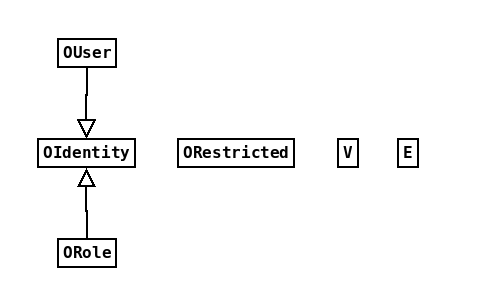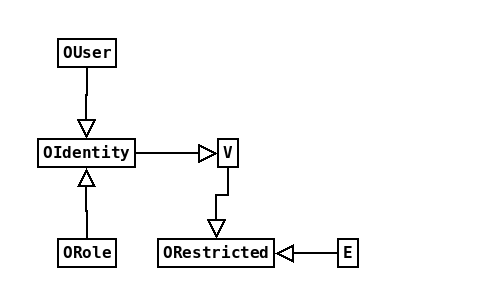Argh Skwidge
I've written a connection pool resource for Tomcat as a working demonstration. It's not perfect implementation but it illustrates a possibility that the existing OrientDB pools don't quite support.
Essentially the idea relies on record level security and a customised inheritance model for Odentity class and sub-classes.
A Graph User Model
There are six classes that are of interest to us when defining the user model in an OrientDB graph database. The classes and their relationships in a freshly created graph database are shown below. As you can see OUser and ORole both extend OIdentity, but none of the other classes have any particular relationship.

OUser and ORole must extend OIdentity, in order to be part of the OrientDB security model. But wouldn't it be
useful if our users could part of a graph? The easiest way to achieve this is to let OIdentity extend V. Now
Our users can also be nodes in a graph.
Just as a note, OrientDB versions 2.1 and later allow multiple inheritance, which would allow OUser or ORole to
extend both OIdentity and V. This would allow more flexibility in how one structures this.
We also would like to apply record level security to all the elements of our graph, including the users. We can do this by letting V, and possibly also E, extend ORestricted, as recommended in the manual. Now our class diagram looks like this:

The Benefits
At this point database users are first class citizens of our graph and can be queried like any other graph
component. The records they create (including new roles and users) can be governed by record level security.
Now let's say we create a web application that allows users to sign up and log in. We still need to write the
user interface for these functions, but we no longer have to develop a user model, permissions model, etc. We
get these for free.
Any new records created by a user are only available to that user by default, so long as we ensure those records extend ORestricted. If we want to make the records more generally available we must do so explicitly either by policy or specific action. New restricted records are created secure by default.
This directly mitigates the risk of one of the most common web application vulnerabilities -
insecure
direct object references. Every reference to a vertex or edge in our graph gets access checked for free.
It indirectly mitigates some of the risk of
broken
authentication and session management, in as much as it allows this functionality to be delegated to the
database. Authentication is handled directly by the database. Session management remains the responsibility of
the web application, but this can be delegated to the container. Using OdbRealm and OdbResource, authentication
and session management become a task of configuration rather than coding.
There is a significant non-security related benefit here as well. Developers still get tasked with writing
boilerplate authentication and authorisation management code for far too many web applications. Having this
provided is a real timesaver.
It potentially mitigates some of the risk of
missing
function level access control. It does this by protecting access to the underlying data. For example, a
blog user might have write access to their own posts but only read access to another user's posts. A malicious
user might find a way to invoke edit functionality on another user's blog, but the edit would still fail because
of access checks.
The Risks
There is a flip-side to making all your users database users. An OrientDB database engine usually listens on a couple of ports and a malicious user could potentially log in on any of them and execute arbitrary queries, if they were to gain network access and the credentials of any user. The queries would still be governed by the same security model though, and sensible firewall, network and database configuration should provide sufficient protection from this.
Scalability
The biggest issue is the potential for scalability issues due to the OrientDB connection and authentication model.
OrientDB encapsulates a connection to a graph database with an instance of the class OrientGraph. The credentials must be passed in at instance construction. This means at least one OrientGraph instance must be created for each logged in user. This will eventually hit limits with large numbers of users.
Connection Pooling
If this were a traditional DB user model, with a small number of database users servicing all web users, connection pooling would be a relatively simple task. But here every logged in web user requires at least one distinct OrientGraph instance, at least for the duration of a given request. Creating a new OrientGraph instance is a relatively expensive operation.
Embedding the database in the web application goes some way to solving this problem by removing the need for any kind of socket resource. However we still want to avoid creating a new OrientGraph instance for every request.
I have not done any benchmarking on OrientDB to see just how many concurrent OrientGraph instances can be used,
nor am I aware of any benchmarking by anyone else, including
Orient Technologies.
Solutions
The OdbResource library provides a pool for OrientGraph instances, but it is a kludge. OrientGraph instances are created for a particular user and can only be used by that user. They are recycled across requests, but once the number of logged in users exceeds the maximum number of connections in the pool, existing OrientGraph instances must be constantly destroyed so that new instances can be created for other users. What it mostly does is allow us to tune the total number of OrientGraph instances per application (and per user.) This at least allows a web application to fail more gracefully.
What is required is the ability to cheaply re-authenticate existing OrientGraph instances with new sets of credentials. This would allow the creation of a proper connection pool. But this solution requires a patch to OrientDB. It can't be achieved just by library interacting with OrientDB's public API.
So this post is in part a plea to Orient Technologies, the company behind OrientDB, to support these ideas. A better solution than OdbResource requires changes to the OrientDB codebase. I would like to write a patch, but there would be a considerable amount of work involved in producing and then maintaining it. It would help a lot to know Orient Technologies were interested in supporting this model of use of OrientDB.
Andrey Lomakin
Hi ,
Your solution is really interesting and deserves to be published to wide audience .
But problem with creation of OrientGrah instances with many users have already been solved by us .
You see OrientGraph is merely think wrapper on ODatabaseDocumetTX instance , creation of which I agree is expensive task . To solve problem when you have millions of users in database we have created OPartitinedDatabasePoolFactory which is lock free LRU list of connection pools for each user , each connection pool not only lock free but for many classes wait free because it tries to partition load between active CPU cores ( indirectly of course ) . According to our benchmarks acquring of connection from this pool requires nanoseconds . When you acquire database instance you merely wrap it in OrientGraph instance which is cheap operation . Could you try this approach and send us feedback ?
--
---
You received this message because you are subscribed to the Google Groups "OrientDB" group.
To unsubscribe from this group and stop receiving emails from it, send an email to orient-databa...@googlegroups.com.
For more options, visit https://groups.google.com/d/optout.
Argh Skwidge
Thanks, that is a solution I had completely missed, I will try that. It looks like I wasted a bit of time there writing my dodgy connection pool :-/
I notice OPartitionedDatabasePoolFactory is not even mentioned in the manual and OPartitionedDatabasePool is mentioned only briefly. When I get an opportunity I might write something up and post it here. I think this is a use case other people might be interested in.
Andrey Lomakin
Argh Skwidge
I will probably post on here, on LinkedIn and update the OdbResource project on Github. I think the realm and resource factory will still be useful.
